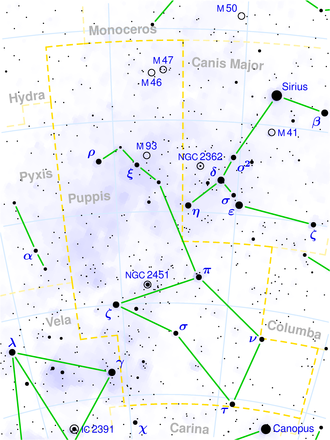Naos (star)
|
Star ζ Puppis (Naos) |
|||||||||||||||||||
|---|---|---|---|---|---|---|---|---|---|---|---|---|---|---|---|---|---|---|---|
| AladinLite | |||||||||||||||||||
|
Observation dates equinox : J2000.0 , epoch : J2000.0 |
|||||||||||||||||||
| Constellation | Aft deck of the ship | ||||||||||||||||||
| Right ascension | 08 h 03 m 35.05 s | ||||||||||||||||||
| declination | -40 ° 00 ′ 11.3 ″ | ||||||||||||||||||
| Apparent brightness | 2.21 mag | ||||||||||||||||||
| Typing | |||||||||||||||||||
| B − V color index | −0.26 | ||||||||||||||||||
| U − B color index | −1.11 | ||||||||||||||||||
| R − I index | −0.22 | ||||||||||||||||||
| Spectral class | O5 IAf | ||||||||||||||||||
| Astrometry | |||||||||||||||||||
| Radial velocity | (−23.9 ± 2.9) km / s | ||||||||||||||||||
| parallax | (3.00 ± 0.10) mas | ||||||||||||||||||
| distance | (1090 ± 40) Lj 335 +12−11 pc |
||||||||||||||||||
| Visual absolute brightness M vis | −5.4 mag | ||||||||||||||||||
| Proper movement | |||||||||||||||||||
| Rec. Share: | (−29.71 ± 0.08) mas / a | ||||||||||||||||||
| Dec. portion: | (16.68 ± 0.09) mas / a | ||||||||||||||||||
| Physical Properties | |||||||||||||||||||
| Dimensions | 59 M ☉ | ||||||||||||||||||
| radius | 20 R ☉ | ||||||||||||||||||
| Effective temperature | 42 500 K | ||||||||||||||||||
| Rotation time | 15 days | ||||||||||||||||||
|
Other names and catalog entries |
|||||||||||||||||||
|
|||||||||||||||||||
| annotation | |||||||||||||||||||
|
|||||||||||||||||||
Naos ("ship"), Bayer name Zeta Puppis (ζ Puppis), is the brightest star in the constellation aft deck of the ship (lat. Puppis). It is a blue supergiant and belongs to the spectral class O 5 Ia. It is about 1100 light years away. It has an apparent magnitude of approx. 2.25 mag. The name Naos was added to the official list of star names by the IAU on August 21, 2016 . Another historical name is Suhail Hadar ( Arabic سهيل هدار, DMG Suhail Hadār ).
Due to the division of the former constellation Argo Navis into the constellations aft deck of the ship , keel of the ship and sails of the ship , these have a common "set" of Bayer designations and Naos, therefore not alpha, but zeta as a large letter. The brightest star Alpha of Argo Navis is Canopus in the constellation Kiel des Schiff.
Naos was the main star of the ancient Egyptian constellation Stars of Water .
It is believed that the star belongs to a relatively rare group of stars, the blue stragglers .
See also
Web links
Individual evidence
- ↑ a b c Hipparcos catalog (ESA 1997)
- ↑ a b c Bright Star Catalog
- ↑ Pulkovo radial velocities for 35493 HIP stars
- ↑ a b Maíz Apellániz et al .: "Accurate distances to nearby massive stars with the new reduction of the Hipparcos raw data"; Poster for the IAU Symposium 250 from December 10-14, 2007
- ^ Hipparcos, the New Reduction (van Leeuwen, 2007)
